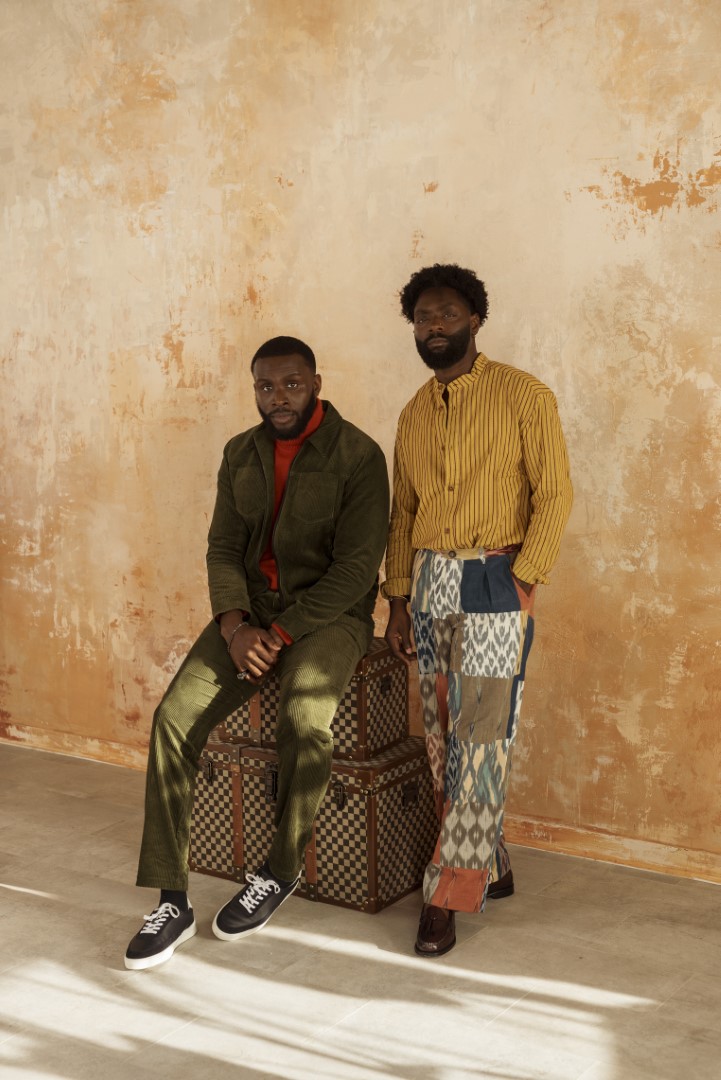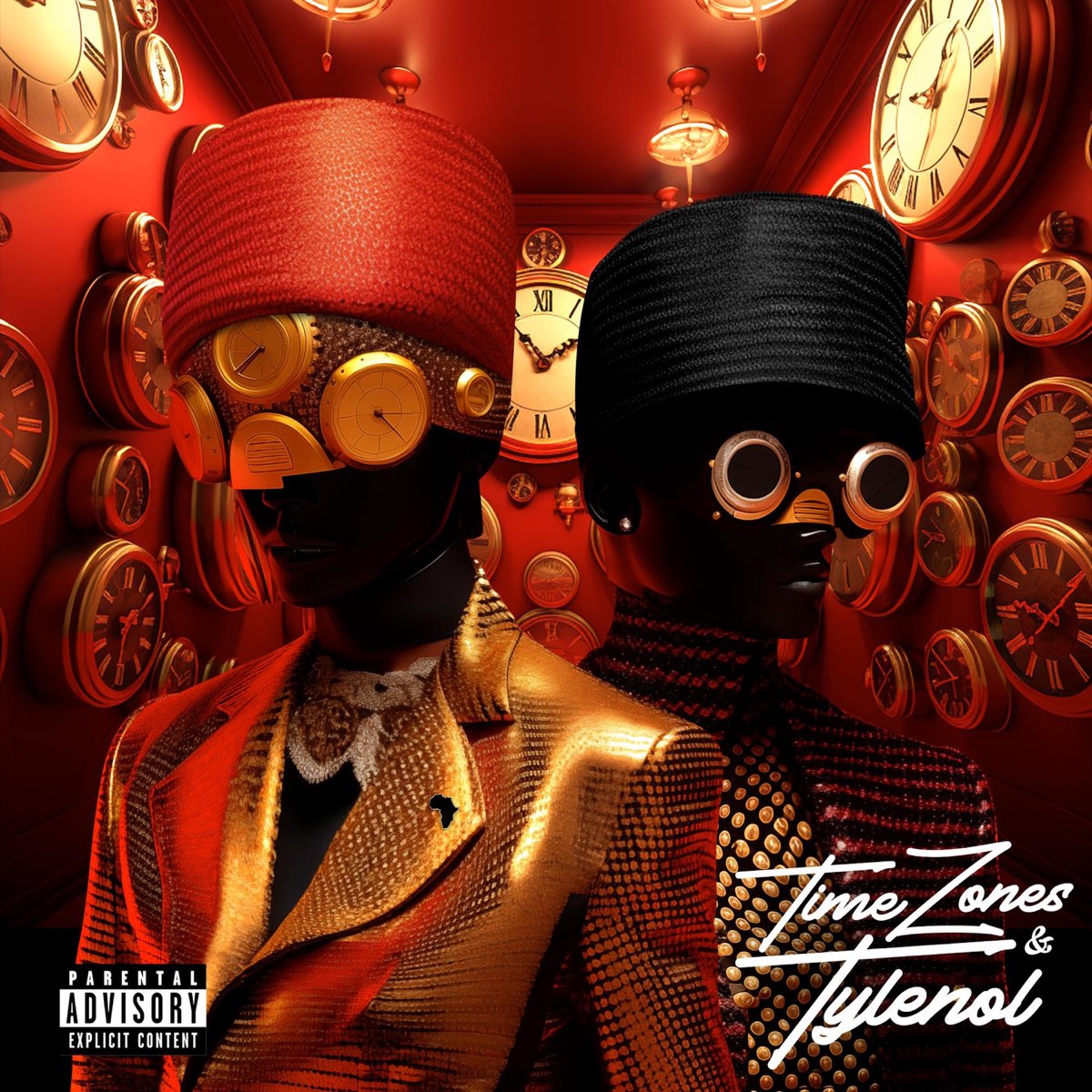Sons of Sonix

Sons of Sonix are a production duo who have graduated from working behind the scenes with huge names like Stormzy, Justin Bieber and Ariana Grande to releasing their own records with huge names like Chip, Jacob Banks and more. Last month saw the release of their debut album, Time Zones and Tylenol, which arrived after several years of highly-acclaimed single releases. With a title alluding to the duo’s international outlook, the album similarly incorporates genres that reflect their Nigerian heritage, London upbringing, and current LA lifestyle: from Afrobeats to hip-hop and R&B.
We caught up with Sons of Sonix, aka Mikey Akin and Mo Samuels, to discuss their latest release, the challenges of being in the spotlight, ongoing racial prejudice in the UK music scene, and more…
FAULT: You’ve spoken in the past about the importance of reinventing yourselves and your music. You’ve been releasing music as SOS since 2018: how does Time Zones and Tylenol compare to your earlier work?
Sons of Sonix [Mikey]: Time Zones & Tylenol marks a significant evolution in our music, reflecting how we’ve grown both personally and artistically since we first started releasing music as SOS. Our earlier work was more about exploring our sound and establishing our identity. With this project, we’re pushing boundaries even further, diving into deeper, more complex themes, and experimenting with new styles and production techniques. It’s a more mature, introspective body of work, yet it still holds onto the raw emotion and energy that have always been at the core of our music. We’re always looking to reinvent ourselves, and this project is a testament to that ongoing journey.
You cut your teeth in music production. How different is it to be the faces of the project rather than the guys behind the scenes?
[Mo] It’s definitely a shift to step into the spotlight as the faces of the project, rather than just being behind the scenes in production. When you’re producing, you can focus purely on the music— crafting sounds, refining beats, and bringing a vision to life. But being the faces of the project adds a new layer of responsibility and vulnerability. You’re not just creating the music; you’re also representing it, connecting with the audience on a personal level, and sharing your own stories. It’s both challenging and rewarding because it forces us to be more open and authentic, which ultimately brings a deeper connection to the music and the people who resonate with it.
Despite multiple singles and collabs over the past 8 years, this is your first album release. Was that out of choice or were there other factors at play? And why now?
[Mo] It was definitely a bit of both—choice and circumstance. We’ve always been intentional about the music we release, focusing on singles and collaborations because we wanted each track to stand on its own and tell its own story. That approach allowed us to experiment and evolve without the pressure of creating a cohesive album. But at the same time, life has a way of shaping your journey. Over the years, we’ve grown, faced challenges, and experienced things that we felt needed to be captured in a larger, more complete project. Time Zones & Tylenol is the culmination of that journey—a reflection of where we’ve been and where we are now. The timing just felt right; we finally had a story we were ready to tell in its entirety.

I like how you talk about ‘expensive music’: getting all the individual tracks on the mix perfectly balanced. There are a lot of collaborators on T&T – is it harder to get that right when you’ve got lots of different voices and opinions involved?
[Mikey] Absolutely, getting that perfect balance becomes more challenging when you have multiple collaborators with different voices and creative perspectives. But at the same time, that’s what makes the process so rewarding. Each collaborator brings something unique to the table, and it’s our job to make sure those individual elements complement each other rather than clash. It takes a lot of communication, patience, and sometimes compromise to ensure that everyone’s vision is respected while still serving the overall project. But when it all comes together, it creates that ‘expensive’ sound we’re after—something rich, layered, and full of depth. The challenge is part of the process, and it pushes us to be better producers and artists.
The album title references your international outlook, which sees you constantly bring together influences from London, Nigeria, LA and more. There must be a lot of challenges working like that in terms of working across borders/timezones and nailing down a particular fan base. How have you found that? And do you plan on focusing more on an individual market going forward?
[Mo] Working across borders and time zones definitely presents its challenges, but it’s also what gives our music its unique flavor. Bringing together influences from London, Nigeria, LA, and beyond allows us to create something that’s truly global—an authentic blend of cultures and sounds. It can be tough to coordinate when everyone’s in different time zones, and it can be tricky to connect with a specific fan base when your influences are so diverse. But we see that as a strength rather than a limitation. Our music isn’t tied to one place or one market; it’s for anyone who resonates with it, no matter where they’re from.
As for focusing on an individual market, we’re always open to exploring that if it feels right. But for now, we’re more interested in continuing to create music that reflects our diverse backgrounds and experiences. It’s a big world, and we want our music to reach as many corners of it as possible.
You’ve worked with so many huge names in the industry: Stomzy, Ariana Grande, Krept & Konan, Justin Bieber…the list goes on! Chip features on the first track of T&T, but who else from your “collaborated with” list would you most like to appear on an SOS track?
[Mikey] We’ve been fortunate to work with some incredible artists, and each collaboration has brought something special to our music. There are so many names on that list who we’d love to bring into the SOS world, but if we had to pick, someone like Justin Bieber would be at the top.
You’ve spoken in the past about how the industry in the UK limits black producers to working almost exclusively with “urban” artists, which is one of the reasons you relocated to LA. Do you think that’s still the case? If so, how long do you think it’ll take before that changes?
[Mikey] Unfortunately, the industry still has a long way to go when it comes to breaking down those barriers. In the UK, there’s definitely been some significant progress, but black producers are often still pigeonholed into certain genres, primarily working with “urban” artists. It’s a reflection of broader industry stereotypes and a lack of opportunities to showcase versatility in different musical spaces. That was one of the key reasons we moved to LA—where the industry feels more open to experimenting and blending genres.
As for when things will fully change, it’s hard to say, but we’re hopeful. The conversation around diversity and representation in music is louder now than ever before, and more artists and producers are pushing back against being boxed in. Change will come as more voices demand it and as the industry recognises the value in diversity of sound and talent. But it’s going to take continued effort and, most importantly, a shift in mindset from the gatekeepers who make the decisions.
If you weren’t making music, what would you be doing?
[Mo] If I weren’t making music, I’d be fully immersed in the fashion and modelling world. Fashion has always been a huge passion of mine—it’s another way to express creativity and tell a storywithout saying a word. I could see myself working on my own clothing line or collaborating with major brands to push the boundaries of style. Modelling, too, is something I’ve grown to love because it’s about bringing a vision to life in front of the camera. So, if music wasn’t in the picture, I’d definitely be channeling all my energy into the fashion industry, making waves in that space.
[Mikey] I’d probably dive into visual directing and producing full-time. I’ve always been passionate about creating compelling visuals and telling stories through film and imagery. Whether it’s directing music videos, working on commercials, or crafting visual art installations, I’d be focused on bringing ideas to life through the lens. It’s all about creating a powerful narrative and connecting with people in a different way, and that’s something I’d love to do if music weren’t my main gig.

Who is overrated/underrated?
[Mikey] When it comes to being underrated, Oxlade is definitely someone who deserves more recognition. His talent is exceptional—he’s got a unique sound and incredible vocal ability that doesn’t always get the spotlight it should. On the other hand, it’s hard to label anyone as “overrated” because musical taste is so subjective. What might not resonate with one person could be deeply impactful for another. It’s all about appreciating the diverse range of talent and letting each artist shine in their own right.
After the release of T&T, what else can we expect from you in the near future? Anything you’re particularly looking forward to?
[Mo] After the release of Time Zones & Tylenol, we’re excited to dive into a few new projects. We’re already working on some fresh music and exploring new collaborations that we think will surprise and delight our fans. Besides that, we’ve got some creative visual projects in the works— think more music videos and maybe even some fashion collaborations. We’re particularly looking forward to continuing to push our boundaries and explore new artistic directions. There’s a lot on the horizon, and we can’t wait to share it all with you.
What is your FAULT?
Our FAULT is loving music too much and not always aligning with the system of the music business. It’s easy to get caught up in the passion for creating and sharing music, but navigating the industry’s complexities and politics can be challenging. Sometimes, that passion can lead to frustration when the business side doesn’t always match the artistic vision. But it’s all part of the journey, and finding a balance between the two is something we’re constantly working on.